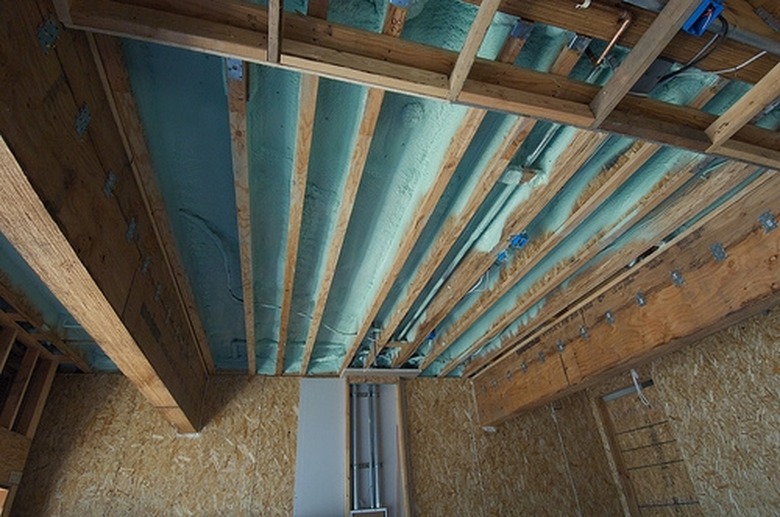How To Insulate A Metal Roof
Things Needed
-
Plywood sheathing
-
Building paper
-
Nails
-
Rigid foam insulation
-
Duct tape
-
Fiberglass batts
-
Spray foam insulation
-
Mop or paint roller
-
Elastomeric roof coating
Tip
Consider covering an existing metal roof with an elastomeric coating. This material is applied with a mop or paint roller, and has a bright white finish. It has some insulating properties. Its white coloring helps to reflect the sun and keep the home cooler in the summer.
Metal roofs are made from steel, copper or aluminum panels. They are used in commercial and residential structures to protect against weather and other exterior elements. Metal roofing is one of the most durable and long-lasting roof materials on the market, and can easily last for decades with little maintenance. To maximize the energy efficiency of these roofs, the roof structure must be properly insulated. You can insulate a new or existing metal roof using a variety of different techniques.
Insulating a New Metal Roof
Step 1
Install plywood or oriented-strand board (OSB) to act as structural roof sheathing. Lay the plywood perpendicular to the roof joists and fasten it in place using galvanized or stainless steel roofing nails.
Step 2
Layer building paper over the sheathing to help protect against moisture and leaks. Overlap each sheet of building paper by six inches and fasten it to the sheathing using nails or staples.
Step 3
Install sheets of rigid foam insulation over the entire roof surface. Butt the sheets closely together but do not allow them to overlap.
Step 4
Seal the seams between the sheets of insulation with duct tape to further protect against moisture. The duct tape will also help prevent air leaks and maximize the insulating ability of the roof.
Step 5
Install the metal roofing panels over the insulation in accordance with the manufacturer's installation instructions.
Insulating an Existing Metal Roof
Step 1
Examine the underside of your metal roof from inside the attic. You will likely be able to see a layer of plywood roof sheathing supported by some type of framing system. Small horizontal framing members are known as purlins, while larger angled beams are known as joists.
Step 2
Place fiberglass batts into any gaps you can find between the purlins and the sheathing. Fiberglass insulation tends to be less effective if it is compacted too tightly, so try to fit it loosely into any available space. Joists are usually set tighter to the roof, so it is often not possible to fit insulation behind them.
Step 3
Use rigid foam insulation to cover wider spans of roof sheathing between joists. Cut each sheet to the desired size using a utility knife, then fasten it in place using staples or adhesive. Avoids nails or screws, which could penetrate the metal roof and cause leaks.
Insulating with Spray Foam Insulation
Step 1
Purchase or rent a spray-foam insulation kit, including a sprayer and a supply of closed-cell liquefied foam. These materials can be found at most home improvement and hardware stores.
Step 2
Cut a small hole in your ceiling so you can access the roof framing. Use the instructions included with your sprayer to determine where to cut the hole and how big it should be.
Step 3
Check around the ceiling to ensure your metal roof is supported by plywood or OSB sheathing. Some metal roofs are installed without this sheathing. If your metal roof does not have plywood installed underneath, you should not attempt to install spray foam yourself. It could spread through the seams in the roof and cause significant damage.
Step 4
Spray the foam insulation into the hole carefully according to the manufacturer's instructions. The foam will expand to fill the roof structure. Patch and repair the drywall to complete the installation.
